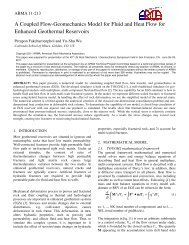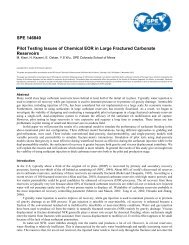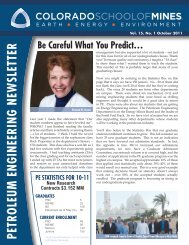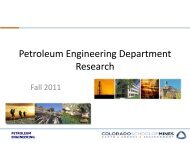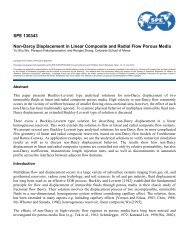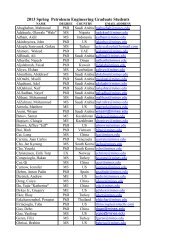2001 Alumni Newsletter - petroleum engineering colorado school of ...
2001 Alumni Newsletter - petroleum engineering colorado school of ...
2001 Alumni Newsletter - petroleum engineering colorado school of ...
You also want an ePaper? Increase the reach of your titles
YUMPU automatically turns print PDFs into web optimized ePapers that Google loves.
on the fly. I appreciate the help from Dave and<br />
Ed Mayer and Richard Christensen. The Department<br />
<strong>of</strong> Conservation <strong>of</strong> the State <strong>of</strong> California led<br />
us in a great discussion <strong>of</strong> government’s role in<br />
oil and gas operations. Our thanks go to Randall<br />
Adams, Dave Clark, Bert Ellison, Dave Tuttle,<br />
and Mike Woods.<br />
Thursday, Mike Clark <strong>of</strong> Chevron took<br />
us to the western San Joaquin Valley for a study<br />
<strong>of</strong> outcrops <strong>of</strong> turbidites and diatomite as well<br />
as a few oilfield history lessons. We saw some<br />
real history west <strong>of</strong> McKittrick at some oil seeps,<br />
including one seep that you could ignite into a<br />
ball <strong>of</strong> fire (a small one that is). That afternoon,<br />
the curator and her staff at the Western<br />
Kern Oilfield Museum gave us a tour <strong>of</strong> the museum.<br />
That is a very nice place to visit and I can recommend<br />
it. Then came the worst part <strong>of</strong> the<br />
trip: driving through LA traffic at rush hour to<br />
get to Long Beach. We survived it; just don’t<br />
get in a hurry.<br />
The last day <strong>of</strong> the field trip was spent<br />
at Oxy’s Long Beach THUMS unit. Tom Turner<br />
and Pat Mays took us to a rig at Pier J and on<br />
to Island Chaffee. There, and back at their Long<br />
Beach <strong>of</strong>fice and at the Broadway Street Production<br />
facility, they and Gerial Holman, Kevin<br />
Olsen, Sonya Chavez, and Ted Walker showed<br />
us their operations from spud to sales.<br />
We left California later that day. I am<br />
pleased to say we didn’t lose any students, at<br />
least until we got to LAX. They all showed up<br />
in PEGN 311 this semester, so they all made it<br />
back.<br />
Elsewhere in this newsletter, much has<br />
been written about the loss <strong>of</strong> a dear colleague.<br />
I want to add my condolences to Robert’s family,<br />
too. As I have told some <strong>of</strong> you, the department,<br />
the <strong>school</strong>, and the industry has lost<br />
a great teacher and leader. We may find someone<br />
to teach economics, but we will never find<br />
anyone to replace Robert Thompson.<br />
John R. Fanchi<br />
Teaching. Research. Service. These three<br />
tasks are the balls that have to be juggled by a<br />
member <strong>of</strong> the faculty. Let me begin with teaching.<br />
One <strong>of</strong> my ongoing tasks is to keep teaching<br />
materials current in an industry that is rapidly<br />
changing. We are continuing to refine the<br />
content <strong>of</strong> classes that are jointly taught by<br />
PE, Geology, and Geophysics faculty. The courses<br />
are focusing on topics that are important to<br />
industry and to society. The topics last year<br />
included reservoir heterogeneity and coalbed<br />
methane production. I have prepared a booklength<br />
manuscript called Shared Earth Modeling<br />
that presents a succinct introduction to<br />
background material in the geosciences and <strong>engineering</strong>.<br />
The manuscript is used to supplement<br />
lectures in multidisciplinary courses and<br />
served as the primary text in an online integrated<br />
reservoir characterization course.<br />
The next edition <strong>of</strong> the book I use in my<br />
senior reservoir <strong>engineering</strong> class, Principles <strong>of</strong><br />
Applied Reservoir Simulation, 2 nd Edition, is<br />
now in print. Its final release was delayed by<br />
an acquisition in the publishing industry. Sometimes<br />
it’s nice to see that our industry is not the only<br />
industry that is changing. The new edition has<br />
been designed to make<br />
a smoother transition<br />
with the first semester<br />
course in reservoir <strong>engineering</strong>,<br />
and includes<br />
a Windows-based flow<br />
simulator. The flow<br />
simulator and an accompanying<br />
3-D visualization<br />
program help students<br />
learn more about<br />
modern reservoir engi-<br />
neering by giving them<br />
hands-on experience<br />
with s<strong>of</strong>tware they can<br />
John Fanci<br />
take with them when the course is over.<br />
The senior seminar in PE has evolved from<br />
primarily oral communication to oral and written<br />
communication on topics <strong>of</strong> importance to<br />
the PE pr<strong>of</strong>ession, including biographies <strong>of</strong> energy<br />
pr<strong>of</strong>essionals, the future <strong>of</strong> energy, ethics,<br />
and lifelong learning. To add some spice to the<br />
course, I worked with Michael Goedecke, a writer<br />
in California, to write Flashpoint: Sakhalin.<br />
The book dramatizes ethical issues in the global<br />
energy industry. It should make classroom<br />
discussions <strong>of</strong> moral dilemmas quite interesting<br />
as students analyze the ethical behavior <strong>of</strong> a cast<br />
<strong>of</strong> characters.<br />
On the research side, we are well into the<br />
first year <strong>of</strong> the Consortium for Integrated Flow<br />
Modeling, or CIFM for short. CIFM has been<br />
established to develop an understanding <strong>of</strong> the<br />
processes and interactions that are needed in a<br />
model-centric system. Integrated flow modeling,<br />
which is the combination <strong>of</strong> a petrophysical model<br />
and a traditional flow simulator, was originally<br />
devised to assist in the design and analysis <strong>of</strong><br />
timelapse seismology. I published many <strong>of</strong> the<br />
background ideas in the 2000 book Integrated<br />
Flow Modeling. We are learning that integrated<br />
11



